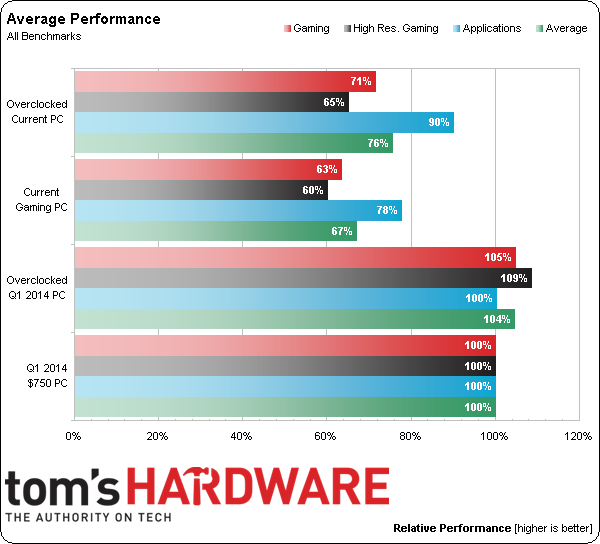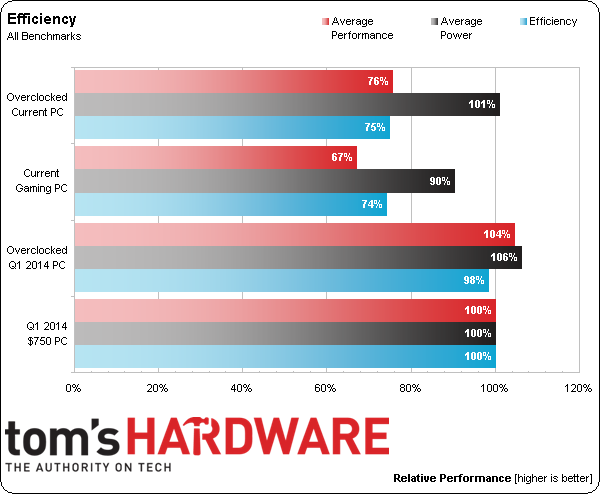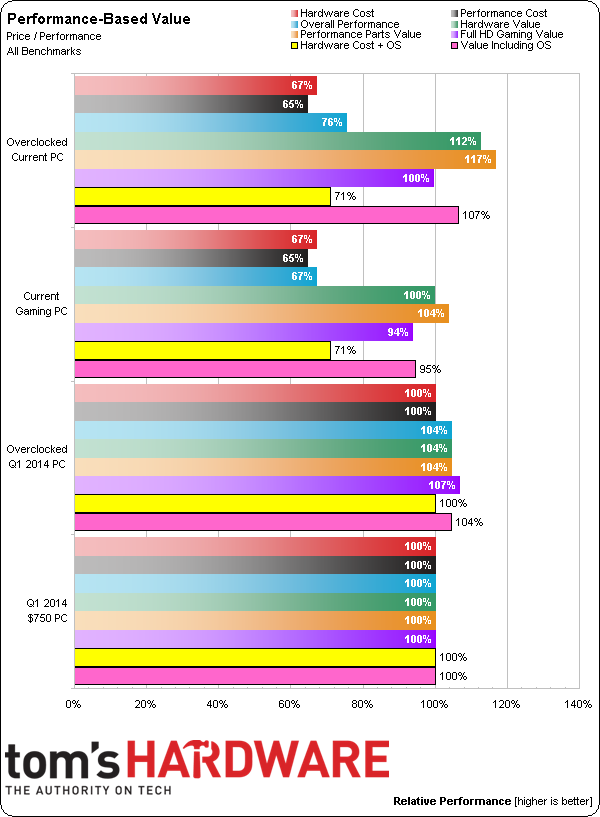System Builder Marathon, Q2 2014: Our Budget Gaming PC
Can Less Funding Compete For Top Value?
Today’s benchmark charts detailed the capabilities of my most recent self-built budget-oriented gaming PCs, priced roughly $250 apart. Obviously, we couldn’t trim off one-third of our funding and expect to compete in an all-out footrace using the same tests. That sort of evolution just doesn't happen over the course of three months. We'd need a revolutionary product/architecture launch able to propel performance and drive down prices.
Both systems are, first and foremost, gaming boxes. So, I consider their performances accordingly. A relatively strong showing in the application workloads will help bolster the overall value of today's more affordable build. But was our newer budget too far below the tipping point of diminishing returns?
On the flip side, a huge reduction in graphics muscle takes a big toll on gaming competency this quarter, particularly at higher resolutions. In fact, most of the demanding AAA titles we tested weren't playable in Full HD without some sort of quality compromise. Then again, to be fair, there are plenty of games that this machine could handle easily, too.
Unfortunately, none of the other configurations can match last quarter’s baseline efficiency. Overclocking the $750 machine’s big-ticket item, the GeForce GTX 770, only helped boost performance in games, while processing fortitude remained unchanged. This time around, the AMD-based platform starts out less efficient, and then requires a voltage bump to go faster. In the process, it picks up a tiny gain in overall efficiency.
Is There A Value Winner?
My second-quarter build might be less efficient than its predecessor, but perhaps it can serve up improved value (even if the sweet spot where you get the most bang for your buck is typically higher than this system's cost). First, we'll focus on the total purchase price of the hardware. Then, we'll consider the performance-oriented price tag, excluding the case and optical drive. Finally, we'll factor in the expense of Windows.
Our new efforts match the overall cost of last quarter's configuration right out of the box. But the platform I used this time also has headroom for processor, memory, and graphics tweaking. Factoring out the cost of the case and DVD burner, my AMD-based box starts pulling away even harder. These machines were both built for gaming though, and this quarter's System Builder Marathon machine shines the brightest in other disciplines. At the most relevant resolution of 1920x1080, a $455 budget for performance parts just couldn't match last quarter's $700+ spend.
As we’d expect, a lower-priced machine takes a bigger value hit from adding the expense of an operating system. That could wind up being a game-changing $100 when we try to pinpoint the cost of peak performance-based value.
Get Tom's Hardware's best news and in-depth reviews, straight to your inbox.
Ultimately, choosing the best value is more subjective than number-crunching might suggest. We have to factor in the games you're playing, the quality settings you expect to use, and the resulting performance output. My Q2 build is going to cost you quite a bit less, but it also might give up too much speed for your favorite titles. After all, it failed to serve up playability at 1920x1080 in three out of the four games we tested. Meanwhile, the $750 PC survived all seven of the titles it faced last quarter.
In the end, I'm still confident that it's hard to beat an Athlon X4 750K with Radeon R7 265 graphics for gaming at this budget level. I probably could have shifted a few dollars from the motherboard to a Richland-based Athlon X4 760K. And certainly, some folks would be better-served by an AMD FX-6300 or Intel Core i3 with cheaper graphics. If we end up keeping these budget levels next quarter, I might even consider the new enthusiast-friendly unlocked Pentium G3258, which posted respectable performance and benefits from a more favorable upgrade path. But I'd need an affordable motherboard able to survive the rigors of overclocking.
This quarter’s Budget Gaming PC isn’t for everyone. But if your funds are limited and you can live with reduced quality settings, it may satisfy your needs. If it were my machine, I’d replace the side-panel intake fan, or simply disconnect it and drop down to a 4 GHz overclock at stock voltage. I can handle a small performance hit in the name of better acoustics. What remains to be seen is whether Don or Thomas handle their new budget levels as gracefully. Game on, guys!
Current page: Can Less Funding Compete For Top Value?
Prev Page Performance Summary-
LookItsRain I myself just could not see buying a setup like this because of complete lack of a CPU upgrade path.Reply -
revanchrist Please stop those nonsenses so called upgrade path. People who buy budget pc won't upgrade their pc before 2-3 years of usage at least. And by the time they are actually upgrading, they will be buying new CPU and new motherboard aka a whole new platform. But still i'll say a combination of G3258 + H97 and overclock it or a i3 4150 + H97 without overclocking will be a better option.Reply -
bemused_fred THANK YOU for finally including the cost of the OS! This is a HUGE budget consideration, ESPECIALLY for those working on low-cost builds.Reply -
Electromikey I'm personally not surprised at all that the ASUS burner was DOA. I've owned four of them, and each one has died within a month of purchase. Not a fan.Reply -
Steve Simons I'd love to see a "vote on the components" build at some point. Each decision would have 3-5 choices with your analysis of why a choice might be good or bad. Then, as readers and enthusiasts, we can vote for our choice and see what wins.Reply -
allanitomwesh Liking the new format and for once,I actually agree with the choices made on this rig!Good show there henningsen,I think it is important to consider that this month's rig,compared to last time at $750,has enough difference in price to graba monitor and keyboarg mouse combo,for a complete system,and that is a win.Reply -
Steve Simons I'm not an expert by any means, so take this with a grain of salt. Would dumping the RAM down to 4 GB have opened up the better graphics card?Reply
The reason why I ask is that budget builders, if they do choose to upgrade anything, typically upgrade RAM (due to the extreme ease at which it can be installed). This way, as they save their pennies they can make the jump from 4 GB to 8 GB while still having the better graphics card that should serve them a bit better and longer than the one in the current system. -
Traciatim I hope you stick with the budgets in the future, it seems pretty silly comparing machines from quarter to quarter with wildly fluctuation budgets. It's also nice that budget actually means entry level budget and that the cap is $1500. It seems like after that amount it just ends up throwing money at things because they sound cool rather than really changing the performance of the machine all that much.Reply
Hopefully next time we will get the see the G3258 in the budget gaming rig since even Tom's own article showed the 3258 pretty much destroying the 750k in games across the board . . . or maybe AMD could come up with something that's actually worth buying over other offerings? -
pauldh Reply13573428 said:I'm not an expert by any means, so take this with a grain of salt. Would dumping the RAM down to 4 GB have opened up the better graphics card?
The reason why I ask is that budget builders, if they do choose to upgrade anything, typically upgrade RAM (due to the extreme ease at which it can be installed). This way, as they save their pennies they can make the jump from 4 GB to 8 GB while still having the better graphics card that should serve them a bit better and longer than the one in the current system.
Actually, you are right on target. This is a big decision for budget-buyers to consider. And here is where I was most torn also. For me it somewhat comes down to current market prices. The way they rise and fall you may grab an 8GB kit later on for the price of a 4GB kit now. Though the reverse has already happened too. We bought 8GB kits for way less in the past. If budget/funding forced me under R7-260X, I'd have dropped to 4GB.
In this SBM series we run our benchmark workloads from the HDD, not RAM Drive, so it (dropping to 4GB)wouldn't show up in our benchmark charts much at all (beyond a few apps, tops). Yet jumping to R9 270 would have yielded notable gains in frame rates, and even offered higher max playable settings. Yet it also feels like a bit of a cheat on my part; a benchmark win, yet also a "daily livability" loss.
IMO computing life with 4GB isn't as productive or enjoyable. Stuttering or hitching in games, lengthened time just to exit games or switch between tasks, and even web browsing slowing to a crawl when too many tabs are open.
I got in the habit of outfitting 8GB when RAM was more affordable, especially when the entry-level mobo in use is limited to two sticks. This one supports four, so starting with 4GB becomes more practical. There's some potential for compatibility issues when adding very different memory kits. (single-sided+dual-sided) But nothing I'd worry too much about.
I'd say budget builders more than anyone should consider building in steps. That's one good reason to build rather than buy. Be it the mobo, CPU, Graphics, PSU, RAM, It's nice know part(s) of your platform has/have staying power, even if you can't afford to do it all well, right from the start.
-
pauldh Reply13572758 said:Please stop those nonsenses so called upgrade path. People who buy budget pc won't upgrade their pc before 2-3 years of usage at least. And by the time they are actually upgrading, they will be buying new CPU and new motherboard aka a whole new platform. But still i'll say a combination of G3258 + H97 and overclock it or a i3 4150 + H97 without overclocking will be a better option.
While I most certainly understand what you are saying, considering the double post directly above it, I'd also like to reiterate budget builders are the ones who should probably MOST consider the upgrade path. If you can afford to hit the upper-mainstream now across the board, fine. You may likely be happy for a few years until your next build. Or at least you'd have the platform to stay with a GPU upgrade, if desired.
But if you can't, then why settle for the disposable platform mentality and not consider advantaging upgrade potential into your plan? Remember some folks aren't keen on starting over with a fresh OS all to often. A large CPU bump while retaining the mobo, can be a huge plus for those who always feel they lack free time. Starting with a Pentium and later popping in Core i7 has huge lasting potential for those short on cash only, but not in computing desires. For my son, I even started with Celeron so he could build his own with me, and now that rig outfits i5-2500K, and the Celeron ported over to a cheap office PC. It was part of the plan all along, but the cheap chip got us up and running quicker within my budget. Best of all, it only took me minutes to upgrade.



